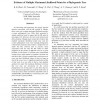11 search results - page 1 / 3 » Evidence of Multiple Maximum Likelihood Points for a Phyloge... |
BIBE
2006
IEEE
13 years 11 months ago
2006
IEEE
An interesting and important, but largely ignored question associated with the ML method is whether there exists only a single maximum likelihood point for a given phylogenetic tr...
IPPS
2009
IEEE
13 years 11 months ago
2009
IEEE
Driven by novel biological wet lab techniques such as pyrosequencing there has been an unprecedented molecular data explosion over the last 2-3 years. The growth of biological seq...
IPPS
2007
IEEE
13 years 11 months ago
2007
IEEE
Computational phylogeny is a challenging application even for the most powerful supercomputers. It is also an ideal candidate for benchmarking emerging multiprocessor architecture...
JACM
2006
13 years 4 months ago
2006
Abstract. Maximum likelihood (ML) is an increasingly popular optimality criterion for selecting evolutionary trees [Felsenstein 1981]. Finding optimal ML trees appears to be a very...
IPPS
2006
IEEE
13 years 11 months ago
2006
IEEE
Inference of phylogenetic trees using the maximum likelihood (ML) method is NP-hard. Furthermore, the computation of the likelihood function for huge trees of more than 1,000 orga...


